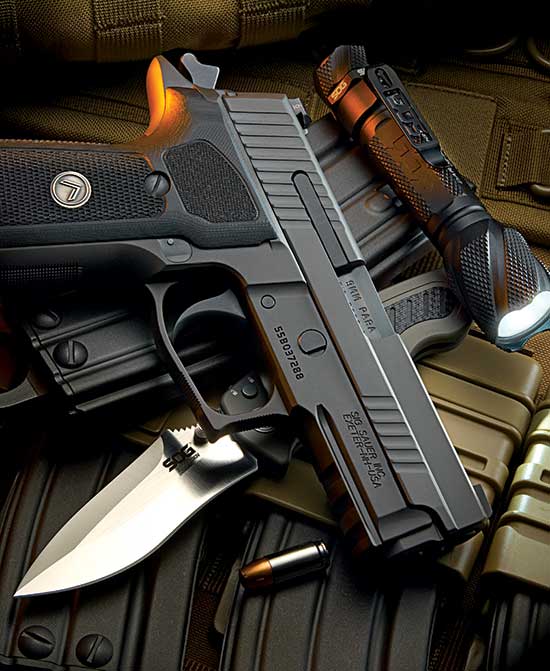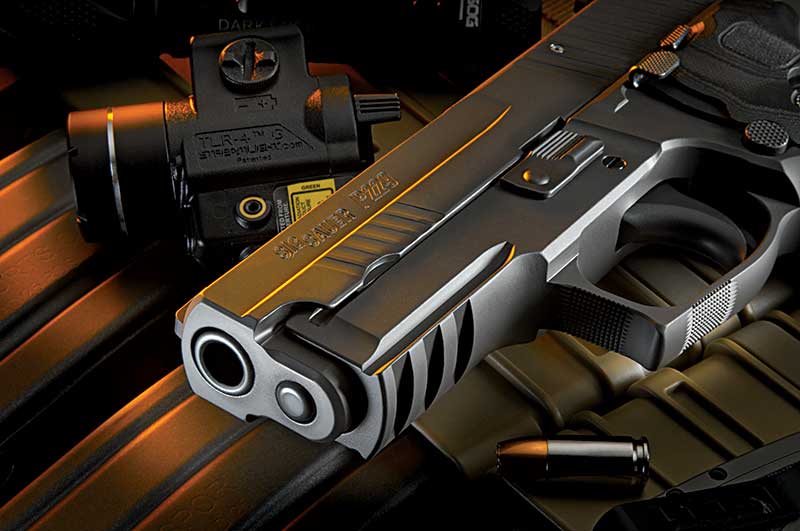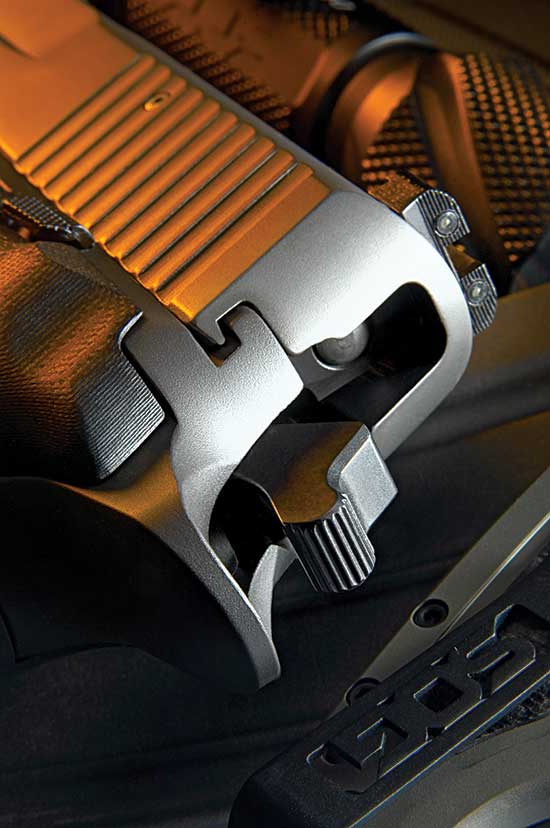SIG's P229/226 Gunfighter
Ready to Join the Legion?
On October 6, 2015, SIG Sauer debuted a new concept in their handgun line: the Legion series of P229 and P226 pistols. Offered initially in 9mm, .40 S&W and .357 SIG (with a cocked and locked, flat-trigger Single Action Only option for the P226), features include a low-profile beavertail grip tang, undercut rear of trigger guard for higher hold, what they call “X-RAY” heavy duty Tritium-plus-fiber optic fixed sights (with the fiber optic encased for durability), G10 grips and aggressive front-strap checkering on the grip frame.
The first differences you see are the cool, smooth gray PVD finish (like their regular Nitron for anti-corrosion and lubricity, but amazingly well matched between steel slide and aluminum frame), and the lambda symbol of the ancient Spartan shields — the signature of the Legion line. The first difference you feel is in the trigger. It’s a Bruce Gray custom set-up, factory honed, and you immediately realize Legion is to SIG as Wilson Custom is to Beretta or Performance Center to standard-line Smith & Wesson in this respect.
SIG put a big brain trust into this series. At the SIG Academy, the ace instructors are constantly picking the brains of SEALs and other top professionals who use their guns for the most serious business, along with top gunsmiths and SIG-shooting champions like Bruce Gray and Ernest Langdon. The trigger is Gray’s own, and the reduced-size slide stop is something I first saw from Langdon.
They’ve also done another marketing coup: Legion buyers get to register for additional Legion accessories ranging from challenge coins to a custom gun case to a series of custom Legion knives from top designers. There will also be an internet newsletter for members of the club, kinda like a prestige motorcycle or sports car clique. I’m withholding judgment on the latter for now. If it becomes a genuine interchange of useful info between gun professionals, it’ll merit a “Yay!”
Perks & Quirks
I didn’t care about the chevron-shaped lambda symbol on the G10 grips, but sure did appreciate the G10’s themselves. They felt very good and there was never the least bit of slippage in temperatures from high 40’s Fahrenheit with wind chill to sweaty upper-90’s with 100 degrees or so heat factor. This was true whether shooting left hand only, right hand only, or Weaver stance. SIG spokesman Allen Forkner tells me SIG’s E2 grips should fit, which pleases me since (subjectively, of course) they’re my favorite.
I carried the Legion for most of a month, and found it as concealable as any P229. The short butt makes it less likely to “print” on an average-sized person like yours truly, and when seated on long drives, was “just right” in it didn’t force the subtle forward adjustment of the gun-side hip leading to lower back pain.
In Texas, addressing the state bar association in a tailored suit, it concealed perfectly in a Leather Arsenal inside the waistband holster by Elmer McEvoy. The same holster hid it well beneath a one-size-larger, un-tucked polo shirt for hot weather casual wear, and (surprisingly) the G10s didn’t chafe bare skin at all. With outer garments, I carried the Legion P229 in a Galco Yaqui Slide and found it comfortable, concealable and fast to draw. The light weight of the aluminum frame was appreciated.
Loved the sights! The enclosed green fiber optic came very quickly to the eye in daylight, but did not overwhelm the shooter’s view of the post in notch silhouette for making precise shots. In the dark, the three green Tritium ampoules glowed equally bright and looked to be equal size.
The Bruce Gray trigger was sweet and perfectly adjusted as it came out of the box. Weighed by Ashley Gibbons at Sand Burr Gun Ranch in Rochester, IN, it averaged 9.99 pounds double action and 4 pounds, 6.58 ounces in single action, almost dead-on with factory spec. The double action was very smooth, even more so than the standard SIG Sauer P-series which is famous for its slick trigger. The single action shots broke clean as a target pistol’s, with no perceptible backlash or movement after sear release.
The subtle beavertail helped the hand get a good grasp at the beginning of the draw but did not prevent the thumb from holding the hammer down while holstering, a safety feature. The bore axis is a bit higher than on a striker-fired gun and therefore gives a little more muzzle rise, but the Legion always seemed to be back on target by the time the trigger re-set in rapid fire. Since I prefer to shoot with a wedge hold, with the index finger of the support hand still under the trigger guard but ahead of the middle finger to cam the muzzle upward and drive the grip tang deeper into the firing hand, the roughening on the bottom of the triggerguard was a welcome bonus for me.
Quirks? The reduced-size slide lock lever does indeed survive the high thumb position so often over-riding the standard SIG Sauer part when shot right-handed with the popular straight-thumbs grasp. However, it also made it distinctly more difficult to deliberately thumb down that lever to close the slide in a speed reload. This will be of no consequence to those who use the slower slide-tug to chamber after a reload, however. The smaller de-cocking lever made de-cocking more difficult for me, and I saw no upside to it.
We found one popular load which would not reliably feed in my test Legion #55B037279: Winchester “white box” 115 grain from two different recently-manufactured lots repeatedly caused extraction failures and, once, ejection failure. Ammo from both lots felt particularly “light” in recoil so I’m thinking it was a light-load issue. But it would serve to check your own gun, regardless of brand, with the ammo you plan to carry.
That said, though, this pistol ran 100 percent with 147-gr. Winchester white box, 115-gr. Blazer Brass, 124-gr. NATO, SIG V-Crown 124-gr. JHP, Speer Gold Dot 124-gr. +P, and Federal 115-gr. +P+. I felt perfectly confident carrying it during the weeks of the test loaded with the latter two rounds.
Accuracy
Due to time pressure I only got to “bench” one group on my home range, with SIG’s own V-Crown 124-gr. JHP going pleasingly well under 2″. On a rare free day in Chicagoland, the helpful folks at the Maxon indoor range in Des Plaines told me I could get 25 yards there. With the timed and rapid bulls-eye targets all the way out, I saw some “4+1” with the first hand-cycled cartridge always landing a little off from the subsequent, automatically-cycled rounds.
This time, the SIG V-Crown 124 grain plunked five shots into a tiny tad under 3″, with the last four in 13/16″! and the best three of those a mere 0.75″ center to center. The 147-gr. subsonic Winchester white box FMJ delivered a 21/8″ 5-shot group, shots 2 through 5 into 11/8″ and the best three in 0.75″. The star of the show was Federal 9PLE 115-gr. +P+ JHP, with all five shots into 13/8″, the last four in the X-ring in a tidy 11/16″ group, and the best three into a mere half inch! Pleasing accuracy, to say the least.
Shootability
Without exception, everyone who fired the test Legion shot well with it. I taught a couple of classes with it, each time shooting a pace-setter run of a timed 60-shot police qualification course encompassing strong hand only, weak hand only, standing two-hand and cover positions. Each time, this SIG Legion gave me a perfect 300 out of 300 on qualification scoring, and in one instance where we used the NRA B-27 target, a 599 out of 600 on the much tighter “PPC competition” scoring rings.
In the Illinois class, the Legion P229 gave me a score which tied Bob Houzenga shooting his 9mm 1911, winning the tie-breaker group measurement by a scant 1/8″ of one inch. Any pistol letting a burned-out old gun-writer beat a six-time National Champion is absolutely worth a four-figure retail price!
Suggested retail is $1,428, and SIG execs tell me they expect the Legion to sell over the counter in the high $1,200 to low $1,300 range. No less an authority than Bruce Gray himself has posted on sigforum.com he considers this a helluva good deal, since all things considered, the restructuring of a standard P229 or P226 to the Legion’s ergonomic configuration would cost more when done by a custom gunsmith.
In conclusion, while I probably won’t be doing much with the owner’s club (though that quarterly newsletter could change my mind, depending how it comes out), I was pleased with the Legion P229R 9mm itself.
Let me close with the words of Nick Deem, an Indiana cop who has won more than one fatal shootout on the street and fits the profile of the “serious user” SIG developed the Legion with and for. After shooting my test Legion Nick said, “I have shot a number of SIG’s in the past and have carried them both on and off duty. They are my preferred weapon platform. This P229 Legion 9mm is the best SIG I have fired yet.”













